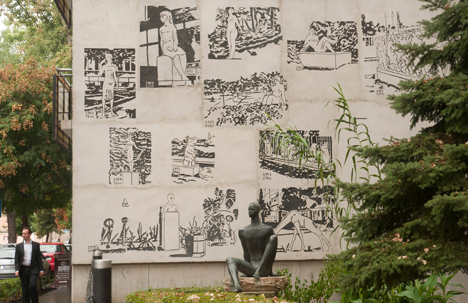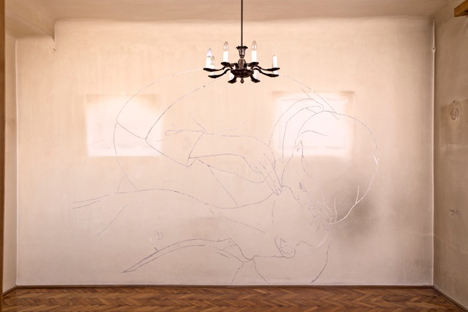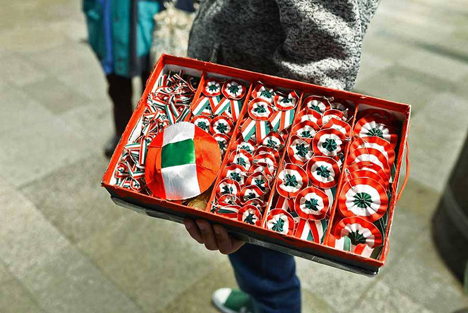
Overlapping crises, enforced political passivity, a new political normal: all things that gradually dismantle a democracy. Ferenc Laczó talks the death of democracy in a new episode of Gagarin.
Art is suffering in Hungary’s oppressively nationalist climate, writes Edit András. Criticism of the state-supported cultural system is weakened by a gradual acceptance of the new configuration; and due to general exhaustion, the protest movement among artists has also lost its vigour.
In tune with “more civilized” countries, and “more advanced” institutions when it comes to exhibiting “primitive humans”,1 the Budapest Zoo also wished to please visitors to its millennial exhibition celebrating a thousand years of Hungarian nationhood in 1896 by displaying 250 “Negros” from Africa. The sensation was reported in the Sunday Newspaper: one could view the almost naked bodies of these “graceful Negros” for just 50 krajcar (the currency at the time), and the spectacle was worth the money, since “they are so very different from us” and, what is more, there is “not a single foul odour among so many savages”. The promotion follows as “a certain aesthetic pleasure enhances the quality of the scenery. Better body shapes are hard to come by. Especially while bathing, the slender Negro figure with the water running off him is a genuine statue cast in bronze.”2 Anna Kárpáti, a Hungarian sculptor, effectively casted in bronze a young African boy in 1967 as a public statue, named Negro Boy. The statue still stands in Óbuda, a district of Budapest. The boy was identified by a young journalist as of a member of Nuba tribe from the Kordofon region of Sudan,3 who had become widely known through George Rodger’s photographs published in National Geographic in 1952. These images had been “reproduced everywhere from postcards and posters to textbooks. For many years, it was a definitive portrait of Africa”.4 Actually, they had been already publicized as “a piece of Africa” in 1896 in Budapest.
In 2012, Szabolcs KissPál created a docu-fiction, entitled Amorous geography, for the publication Zoo-topia. The docu-fiction was about zoo architecture as a taxonomy of national representation.5 In the video the colonial imagination of the late nineteenth century is shifted and adapted to Transylvania, Hungary’s dreamland, a “lost paradise” detached from the country after the Trianon Peace Treaty of 1920. Contemporary artists generally avoid the subject, as it has been appropriated and politicized, including by the extreme Right. The interwar revisionist sentiment that permeated all segments of culture was suppressed under the socialist regime, only to come back again with a vengeance after the collapse of the socialist system. The drive for reconstructing the pre-Soviet past as it is now perceived is apparent in the re-establishment and support of conservative, religious and nationalist culture represented by the Hungarian Art Academy (HAA), a kind of cultural shadow ministry inscribed into the constitution. The increasing reach of the Academy’s power has prompted contemporary artists to organize several protests.6 The other form of jumping back in time is the reconstruction of Budapest’s number one symbolic site, Kossuth Square, which surrounds Parliament. The aim being to recreate the look that the square had in 1944. The revanchist Trianon discourse provided, and continues to provide, a container for projecting post-war feelings and desires, such as melancholy over the loss of an imagined grandeur; the pain of defeat and humiliation, as well as dispatching with any sense of responsibility. By extending victimhood to all sufferers of the Nazi regime, the recently erected Nazi occupation monument in Freedom Square, the other key symbolically charged site in Budapest, denies any accountability for the Holocaust. From the very first moment of its construction, it triggered continuous resistance and galvanized a counter monument, named Living Memorial.7 The contrast between the vertical Nazi occupation monument, made of materials intended to last and safeguarded, and the horizontal Living Memorial, made of fragile, ephemeral materials, is striking and echoes the power imbalance between officially propagated culture and its opposition.
KissPál takes the fantasy of Transylvania as the nest of essential Hungarianness to the extreme in his video, with a scene that shows Admiral Horthy (1868-1957) examining the best available examples of the species to exhibit in the zoo. The artist – one of the initiators of the Living Memorial – breaks the illusion of the sacred bond between the caring “mother-state” and the helpless kinsfolk beyond the border of the shrunken motherland. Thus, KissPál reveals the hidden colonial nature of the overheated affection that can be successfully mobilized in any time of crisis or conflict in order to distract attention away from real problems. By way of a kind of psychoanalytic assessment of unconscious motivations and desires that underlie this love-affair, the artist reverses the narrative of passive victims suffering the effects of an unjust peace treaty into the narrative of an active and aggressive colonial power unable to cope with its own historical accountability. Lifting the veil covering the dark side of modernity – the invention of the “savage”, the Other in the concept of “civilization” – the work calls for reflective re-evaluation and renegotiation of this (chosen and dearly embraced) traumatic event.

Balázs Antal / László Hatházi / Zoltán Fodor, “Fixed Corner”, 2012, Sgraffito. Photo: Gábor Buda.
“Noble savages”, Sudanese people could have been seen again in 1967 in Hungary, but this time not in the zoo. African students studied in socialist countries in the sixties, as connections and exchanges with the economically underdeveloped countries of Africa were important at the time to the practice of international relations in the “world political system”.8 “The slender Negro figure” came to the fore again, emerging from long oblivion in 2013, when Balázs Antal, László Hatházi and Zoltán Fodor created a mural on the wall behind the forgotten public sculpture. This was done at a time when not just socialist realism, but even the socialist period of Hungarian history became illegitimate, a deletion having been inscribed into the constitution, and also when “strangers” from Africa and Asia, let alone migrants, were not at all welcome in post-socialist Hungary.

Balázs Antal / László Hatházi,, 2015. Photo: Dorottya Vékony
On occasion of the OFF-Biennial Budapest, a grass-roots collaborative megaproject operating without any state subsidy or support,9 the same artists created a new mural on the wall of a deserted private apartment. The mural can be interpreted as a kind of cry for help for the agonizing, suffocating contemporary art scene; it is a blown up image from a medical leaflet, illustrating the method of mouth-to-mouth resuscitation. Coincidentally or not, Little Warsaw, a Hungarian artist-duo (András Gálik and Bálint Havas)10 exhibited their newest works at OFF in an abandoned apartment found on the axis between Freedom Square and Kossuth Square, with views looking on to the Soviet monument on Freedom Square, a monument counterbalanced by the Nazi occupation monument. The works were shown alongside a large, coloured paper model of the state-run “lunatic asylum”, nicknamed “Lipót”, constructed by the physicians and patients of the institution. The contextualized artefact could be understood as a subtle reference to the social and mental conditions in the country. Meanwhile, Rudolf Pacsika’s installation in the inner courtyard of a downtown building consisted of a system of discarded wheelchairs arranged in a circle, facing inwards, that functioned with the help of an invisible, artificial “iron lung”, a pneumatic system. The title Riot communicates the exact opposite of what is happening and invokes a mentally and physically challenged, paralyzed society unable to rid itself of its heavy burdens – for the wheelchairs are bound together and even their limited movement is controlled. At the same time, the objects recall the pain and suffering of people, as well as the miserable the people’s miserable quality of life and the declining standards of the country’s healthcare system.11
Johannes Fabian, advocating critical thinking in anthropology, argues for “negativity” in culture, understanding it as a form of resistance, which he considers a political act. “Where negativity is not at the root of thinking and experiencing culture, where reflexivity, self-mockery and other ways of subverting positivity have withered away, there looms collective madness […] such madness manifests itself in ethnic cleansing and massacres, as well as in legally unassailable ways of keeping class and national borders closed in the name of cultural identity”.12 This collective madness is palpably looming in today’s Hungary, albeit not in such extreme forms as Fabian describes. It may be diagnosed by observing the arrogant neglect of democratic principles; schizophrenic manifestations such as applying for European Union money at the same time as proposing rebellion against EU “colonialism”;13 and contravening basic EU principles through initiatives such as the recently advocated death penalty. Paranoia is nurtured in all strata of society by the authoritarian regime, which rewards loyalty and punishes criticism. Concerning culture, punishment is not to be understood as direct punishment; rather there is a widespread tendency to crowd out from the scene those who disagree with the doctrines of the regime. Megalomaniac and narcissistic occurrences – like building a football stadium in the home village of the prime minister, the population of which can’t even fill it, and shoving a mega museum in Budapest’s city park down the art community’s throat while many alternative, advanced cultural institutions struggle for survival – point to the constant abuse of the social contract and test the limits of people’s tolerance.
For now the actual “Lipót” is abandoned and consumed by slow decay. Meanwhile, artworks put the symptoms of a debilitated society to the fore but also offer a cure by naming and displaying the malady.

Agnes Eperjesi,, 2015. Photo: Ádám Urbán.
Source:Agnes Eperjesi
The Living Memorial activist group called upon the artist duo Societé Realiste (Ferenc Gróf and Jean-Baptiste Nandy) to perform their “collective” and “inclusive” anthem in front of the aggressive distortion of remembrance manifested in the Nazi occupation monument at OFF this year. The live performance of the Universal Anthem ensued, an experimental musical composition combining all the anthems of the 193 members of the United Nations by mathematical averaging. The performance disrupted and relativized the ethno-nationalist agenda of the official cultural politics.14 Prior to which, Ágnes Eperjesi’s intervention, entitled National kippah, offered hand-made kippas with the national colours to wear on the national holiday celebrating the 1848-49 Revolution and War of Independence, at a time when anti-Semitic sentiments were running high. She offered rainbow coloured ribbons as well, at a time when anti-gay sentiments were also running high.
In his puppet animation video Stand here! (2010), Csaba Nemes made tangible the way the machinery of “othering” works, and also the psychological process of internalizing stereotypes and prejudices.15 Gallery8’s mission is the liberation of the Roma body, and therefore the liberation of Roma people through exhibitions like Roma Body politics in spring 2015, displayed at a time in which scapegoating Roma people is widespread and tolerating hate-crimes against them common. One of three group shows invited artists to reflect on archival photographs made in early twentieth century and found in ethnographic museums, showing half-naked “gypsy girls” offered to the voyeur gaze in a manner quite similar to the “slender negros” previously dished up for consumption. As curator Timea Junghaus explained in her speech at the opening of the exhibition, “an outrageous number of Roma pictures either fulfil the quite ill-natured desires of the collectors or are simply improper and offensive […] in the exhibition we can only view these, basically, minimized photos with the aid of a magnifying glass. This provocative curatorial decision is not a simple game […] but a gesture emphasizing the act of surveillance, in which we – viewers – become voyeurs”.16 Tamara Moyzes, in her collages entitled Museum of Ethnology I-III (2015), interprets the group of Roma girls put on display in the archival photos as free prey for paparazzi and soldiers; both hordes of men shooting (at) them, whether physically or symbolically. When she adds a group of naked white girls next to the half-naked coloured girls, the clichés and prejudices towards the “ethnographically interesting ones” are immediately undone.17
Elaborating on the notion of negation and resistance, Fabian claims that “what makes culture viable, that is imaginable as a way of living and surviving, is the capacity not only to negate and resist that which attacks you but also to contest that which embraces you or makes you embrace it.”18 This not-so-obvious but rather tricky aspect of resistance is highly relevant to Hungary’s recent past, when blackmailing and seduction have tended to be an even more effective tool than marginalization in the fierce redistribution of financial and cultural resources that has taken place during the drive for (re-)creating the capitalist (post-socialist) bourgeois past and present Hungary. It is noticeable that we witness the second growth of the neo-avant-garde that originally emerged in the late sixties and seventies. Multiple exhibitions pay tribute to that period and the artists who were its hallmark, because of the similarities between the social and artistic climate of the period and that of today. Such similarities are apparent in the moral dilemmas, artistic strategies and forced decisions to take sides in a totally divided (art)scene. However, it is more and more difficult to adapt the heroic Cold War era, countercultural discourse to recent times. Owing to the process of “normalization”, more and more people formerly critical of the centralized system and the rightist transformation of society and the cultural sphere are losing their edge. They are gradually accepting the reality of recent developments in Hungary.
Parallel to this process, attitudes toward notions of neo-avant-garde discourse are changing as well. As the myth of the rigid binary between the official and oppositional culture in the Cold War era is questioned, more and more border crossings, compromises and negotiations with authority are coming to the surface. Certainly nowadays, those in power are more cynical than in socialist times, and methods have also changed and became more sophisticated. There is no need for censorship anymore when financial support (or lack thereof) does the job perfectly, and can be adjusted according to the proper (or improper) attitude of the actor on the scene. Existential threats could also be a good excuse for crawling back under the umbrella of the state-supported cultural system, criticism of which is declining in accordance with the process of gradual acceptance of the new configuration. The once so clearly marked borders have become blurred. Fear of losing state support, commissions or advertisements, depending on what is at stake for the actual firm, organization or venue takes its toll and results in the taming of radical, critical thinking or in withdrawal from alternative events. Due to general exhaustion, the protest movement has also lost its vigour, particularly when compared to the time of Free Artists19 and United for Contemporary Art,20 and also to the regular protest-exhibitions outside Mucsarnok/Kunsthalle.21 Nonetheless, János Sugár’s moving work, Fire at the Museum, an unrealized project from 2010, was refreshed and relocated to a public space in which volunteers kept a fire burning 24/7 during the 40 days of OFF; however, for now it is unclear what kind of fire is to be protected, as just a few people, the hardcore, have maintained the radical and uncompromisingly critical position of the formerly thriving protest movement.22 Other people, who once sat on the stairs of Ludwig Museum protesting against a selection procedure based on political, rather than professional, criteria, and demanding autonomy for art institutions23 are now happily collaborating with institution in one way or another.
Mucsarnok/Kunsthalle also tries hard to explain away why its main venue of contemporary art was given to the HAA, which favours out-dated works that are out of touch with contemporary art-making practices and shown in National Salon-type exhibitions. However, for now the HAA’s strategy has changed since they got everything they yearned for. What was once a private circle of friends with traditional and national ideas has transformed into a powerful public body with huge state subsidy, buildings, institutions and control over positions. Now, it seems, is the time for gaining professional acceptability on the local (art)scene. Thus, they are beginning to embrace artists and art professionals from outside their circle, even those who once took a critical approach and were in favour of the autonomy of art. Esteemed neo-avant-garde artists from socialist times, once respected for their opposition to official art, now blindly accept membership of the Hungarian Art Academy (as well as the generous monthly salary attached to it), or do anything (such as exhibiting and performing in the National Salon of Mucsarnok/Kunsthalle) to compensate for their “renegade” (feminist, abstract, émigré etc.) past in order to be accepted and embraced (for example, Orshi Drozdik). Other highly appreciated artists resign from their posts as a sign of solidarity with the more advanced contemporary art scene, only to quietly re-enter the fray, once out of the spotlight (Bukta Imre, for example). So it is not currently all that clear anymore who the Stranger and who the Other is in the Janus-faced art scene, while those born into the position of Strangers and Others in society can scarcely shrug off the hatred and marginalization they gained once upon a time.
In Fabian’s account, recognition is a condition that makes communication possible. He regards recognition as an agonistic relationship that involves participants in confrontation and struggle, but which also makes possible the avoidance of new closure.24 He believes that mutual recognition can undermine authority as well. This mutual recognition, whether we speak about the art scene or about society, is in short supply in present-day Hungary. When Mucsarnok/Kunsthalle calls for a “cultural roundtable discussion” and invites the International Association of Art Critics (AICA) to hold its meeting in their Salon exhibition to discuss contemporary issues surrounding painting and sculpture, it is as if nothing had happened in Hungary, as if there were such a thing as “pure art” beyond politics. Far from recognition, this expresses rather a desire not only to have a monopoly over the financial sources, cultural institutions and positions, but on top of that, to gain professional legitimization as well, to have it all. “Anthropology with an attitude” offers another way to get a grip, one which the scene might want to follow: “In order to be knowingly in each other’s presence we must somehow share each other’s past […] only when self and other get to the point where they begin to ‘remember the present’ will they be drawn into a process of mutual recognition.”25
Pascal Blanchard, Gilles Boetsch and Nanette Jacomijn Snoep (eds.), Human Zoos: The Invention of the Savage, Actes Sud, 2012
Vasárnapi Újság 35 (1896): 578
See Péter Orosz's findings (in Hungarian): cink.hu/budapest-egyik-legszebb-szobra-titokban-egy-egesz-terke-1678528781
Eszter Steierhoffer (ed.), Zoo-topia, London, 2012
www.e-flux.com/journal/vigorous-flagging-in-the-heart-of-europe-the-hungarian-homeland-under-the-right-wing-regime/; see also J.A. Tillmann, "Monuments and other media", 28 November 2014, Eurozine, www.eurozine.com/articles/2014-11-28-tillmann-en.html (first published in Res Publica Nowa)
William Zimmerman, Soviet Perspectives on International Relations, 1956-1967, Princeton University Press, 1969, 244
Johannes Fabian, Anthropology with an Attitude: Critical Essays, Stanford university Press, 2001, 99
Cf. Ferenc Gróf in Artforum, 5 July 2015, artforum.com/words/id=52055
Cf. for example, Eszter Neuberger, "Art debating the media image of the Roma", Visegrad Insight, 8 April 2014, visegradinsight.eu/art-debating-the-media-image-of-the-roma/
Fabian, Anthropology, 96
See: www.kivultagas.hu/
Fabian, Anthropology, 175
Fabian, Anthropology, 177
Published 28 July 2015
Original in English
First published by Springerin 3/2015
Contributed by Springerin © Edit András / Springerin / Eurozine
PDF/PRINTSubscribe to know what’s worth thinking about.

Overlapping crises, enforced political passivity, a new political normal: all things that gradually dismantle a democracy. Ferenc Laczó talks the death of democracy in a new episode of Gagarin.

Hopes raised in 2019 of municipal counter-hegemony in Hungary have been disappointed. But in Budapest, the idea of progressive local government is kept alive by the movement for housing justice.